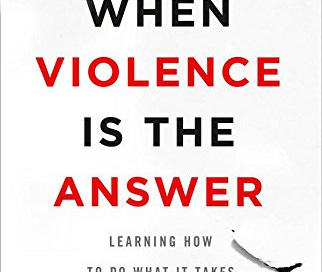[Book Review] When Violence Is the Answer
A review of the book by Tim Lark describe the ethos, pathos, and logos of true violent encounters and how to survive them.
When Violence is the Answer is a book written by Tim Larkin. To the probable disappointment of readers, the title is not a commentary on western politics, nor methods of confronting the Woke progressives. The book is not politically defined at all. It is instead a technical manual. The book is focused on the way violence is regarded in modern western societies, its effects, and its application as a tool and resource.
The book, When Violence is the Answer is a commentary and intellectual training manual on real hand-to-hand combat for life-or-death scenarios. The author makes a distinction between social-aggression (when two opponents utilize violence as a tool for social jockeying, usually peacocking, gesticulating and making threats) and asocial violence (when an individual simply pulls a gun or knife and performs an execution). The book specifically focuses on the necessities (psychological and physical) of asocial violence.
The author, Tim Larkin, utilize a study of prison-fights and assassinations as well as a history in the armed forces to train people in asocial scenarios. He focuses on methods for the application of asocial violence. A skilled martial artist is a dangerous individual, but if he’s trained only in tournament applications, those martial arts are limited when applied to immediate asocial violent encounters. The author focuses on methods of (permanently) disabling a target so that a threat is no longer present.
In context, the author focuses on attacks against weak points in the human body:
Eyes
Ears
The bones of the fingers
The bones of the feet
Knees
Liver and Kidneys
Groin
The author describes a process of visualizing the damage you’re about to inflict on the target, passing through the target to create that damage, and readiness for the inevitable consequences of maiming or killing some one in self-defense. The author emphasizes observation of violence as a tool that can be wielded for good or for evil. A man shanked to death in prison may be considered dispassionately with the simple technical questions “why did that work?” and “how did that work?”
Learning the tools to make those encounters “work” for you is not an act of evil, nor is it immoral. It is learning a set of tools to use that could save your life. This goes for hulking martial arts masters just as much as it goes for 90 lb girls. Being willing, able, and focused enough to perform gratuitous violence when the need arises may well save your life.
The book a technical analysis of the performance of violence against other people and how to do it well. It is a focus on the psychology and physicality. Whether it’s used for good or evil depends entirely on the will of those who have trained in the use of that tool.
Interspersed throughout the text are short-stories where violence is required and performed. The stories are based on true events that the author has learned of form a number of his students at his seminars. They should be read carefully and with the same attitude the text holds: “why did that work?”
While the book was clearly written for a general audience, even skilled martial artists may take instruction from it both in terms of mentality and technique. Most combat-sports techniques (including MMA and Catch Wrestling) focus on winning without permanently maiming your opponent. It happens, but rarely.
The book instead focuses on the other, nastier, part of violence where there are no rules and some one is going to die in the next 30 seconds. The authors instructions regarding mindset and potential targets are useful.
Unlike most martial arts, the book recommends ignoring defense of ones self; the best defense is a good offense. Even in scenarios where your opponent is wielding a weapon, author recommends placing the entire focus of the engagement on maiming the target rather than worrying about defense. There’s no engagement where a weapon is involved where you’re not going to the hospital… so the author recommends eliminating the threat first, and assessing damage second. Always imagine yourself as the guy who is still standing at the end of the encounter.
The author comes from a place of wanting to help people defend themselves. Thus over-emphasizes the fact that a good strike can fell a 200lb wrestler if it’s in the right place with the right amount of force. While that’s true, there’s a reason we use firearms as equalizers. A 200lb wrestler who is fighting for his life is going to be able to do a lot of damage a lot faster. It is not uncommon, however, for big trained guys to hesitate in an engagement because they’ve trained in non-lethal forms of martial combat. In true life-or-death scenarios, hesitation will get you killed.
In total, the book is a condensed form of a Tim Lark seminar on the application of direct asocial violence and a sociological discussion of when that application is necessary. Useful reading for most people, especially given the state of the world here in the early 21st century.
There’s an associated reading list. Tim Lark states in the book that the upper echelons of many cartels require the following books be read by members:
40 rules of power
The Prince (Machiavelli)
A couple of textbooks on human anatomy.
Might be worth thinking about picking a few of those up at the book store next time you’re there.




